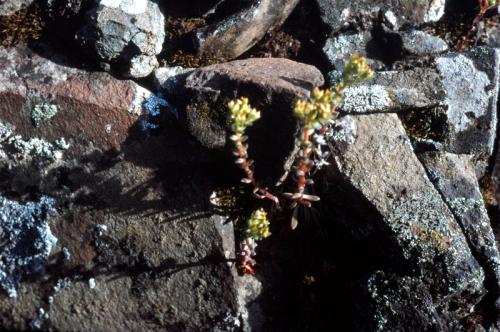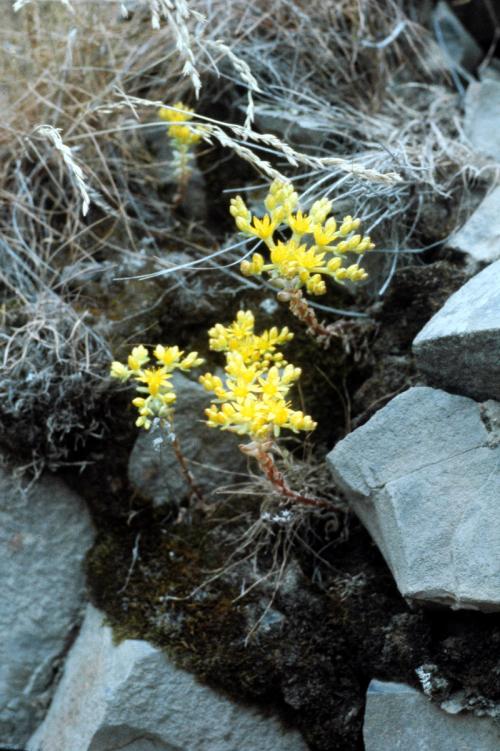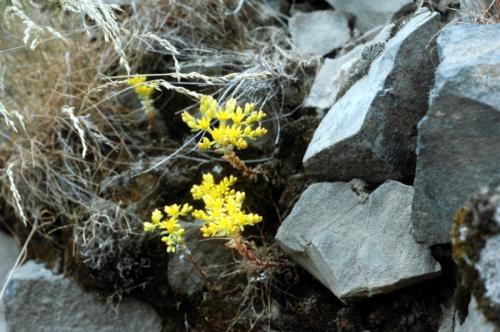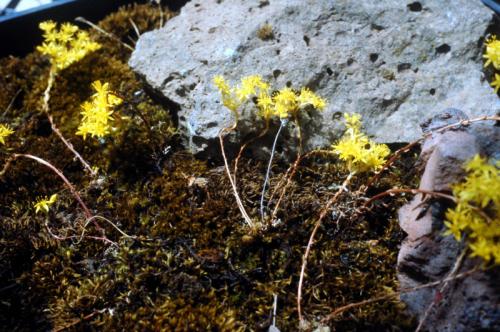LEIBERGII Britton, 1905
Synonyms :
Amerosedum leibergii (Britton) A.Löve & D.Löve (1985)
Sedum divaricatum S. Watson (1882)
Distribution : North western USA (Oregon, Washington, Idaho) ; mostly on basalt or limestone, 260 - 1200 m.
Description (according to IHSP, 2003) :
Biennial herbs with slender rootstock and basal rosettes, axillary shoots with subterranean short white stems, which detach easily and bear tiny terminal rosettes of colourless leaves.
Leaves alternate, oblanceolate, obovate or narrowly spatulate, papillose, ± 9,5 x ± 2,3 mm, outermost lower rosette leaves very long petiolate.
Inflorescences : Flowering branches erect, ± 11 cm, inflorescences cymes with 3 - 6 bracts, each bract 1x or 2x dichotomously forked.
FIowers 5- to 6- (to 7-) merous or more, subsessile, sepals broadly sessile, basally slightly connate, ovate, acute, green, 1,5 - 2 x ± 1 mm, petals nearly free to the base, lanceolate to oblong, subobtuse to acute, carinate, canary-yellow with green or dark red keel, ± 5,5 mm, filaments yellow, anthers yellow.
Cytology : 2n = 16.
The large variation in the number of floral parts (5 - 7 or more) is notable.
Ray Stephenson (Sedum, Cultivated Stonecrops, 1994, p 202) :
Sedum leibergii is one of two species in this volume I have never actually grown, but I do know, due to efforts of enthusiastic conservationists in Oregon, that it is in cultivation. Unfortunately, without very specialist horticulture, it is almost impossible to perpetuate this feeble little plant. It is biennial and has spirally arranged, soft, lax leaves that form tiny, flat, open rosettes. Kyphocarpic yellow flowers are produced on long inflorescences and are unusual in that they are generally 6-partite.
Habitat : The home of this stonecrop is the British Columbian Plateau to Washington, northeastern Oregon, and adjacent Idaho, on cliffs and rocky slopes from about 250 to 1000+ m (820 to 3000+ ft). Sites are wet and mossy in winter and spring, and hot and dry in summer.
Main points of distinction : Weak, lax rosettes and 6-partite, kyphocarpic flowers are unique in North American sedums. Clausen (1975) described carpels as "warty-papillose". 2n = 16.
Variation : Flowers can deviate from the frequently encountered 6-partite.
Horticulture : With care, biennial plants can be perpetuated, since rootstocks form underground buds that emerge and form rosettes the next season. Unfortunately, few growers have succeeded. Despite its delicate nature, healthy plants are attractive, and flowers are bright.



